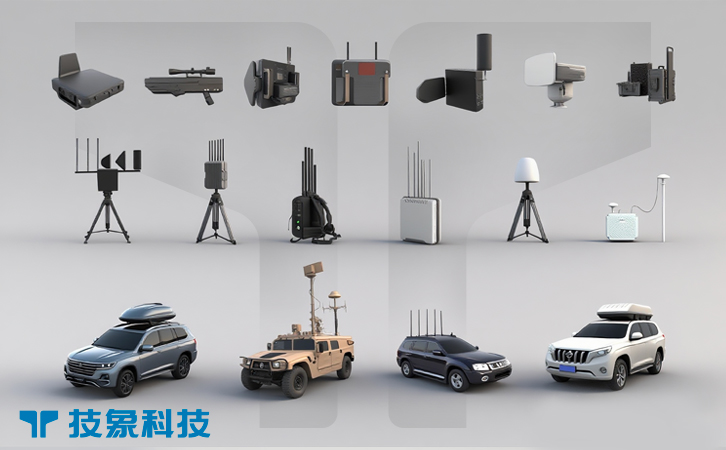The drone surge in 2025, with over 6 million unmanned aerial vehicles (UAVs) in global operation, has amplified threats in noisy or cluttered environments, where rogue drones exploit ambient conditions to evade radar or RF detection. Acoustic counter-drone systems, which use advanced microphones and sound analysis to detect and disrupt UAVs based on their propeller noise, offer a specialized counter-UAV technology. These systems identify unique acoustic signatures and can trigger directional jamming or kinetic responses, ideal for urban areas, wildlife reserves, or military outposts where other sensors struggle. Unlike radar or optical systems limited by line-of-sight, acoustic solutions excel in obstructed settings, providing a complementary layer of defense. This article explores the stealthy drone threat, the mechanics of acoustic systems, their real-world applications, and the challenges and future potential of this sound-based counter-UAV solution.
I. The Stealthy Drone Threat and Need for Acoustic Systems
Rogue drones increasingly operate in environments that mask their presence, with over 2,500 incidents in 2024, including stealthy intrusions over urban events or remote sites, causing disruptions and security breaches costing millions. In military contexts like Ukraine, drones use low-altitude flight to blend into background noise, evading traditional sensors. Civilian risks include smuggling or surveillance UAVs in noisy cityscapes or forests, where radar struggles with clutter and RF fails against signal-silent models.
Conventional detection like radar or cameras falters in non-line-of-sight conditions, while jamming risks interference. Acoustic counter-drone systems address this by leveraging sound signatures, effective in cluttered or noisy settings. Their role is vital for specialized defense, as seen in 2025 U.S. urban trials where acoustic systems detected drones missed by radar. The DEFENSE Act, enacted in September 2025, supports alternative detection for civilian sites, emphasizing acoustic systems’ importance in countering stealthy drones through sound-based surveillance and disruption.
II. Mechanics of Acoustic Counter-Drone Systems
Acoustic counter-drone systems deploy arrays of high-sensitivity microphones to capture drone propeller noise, typically in the 20 Hz to 20 kHz range, analyzing patterns to distinguish UAVs from ambient sounds like traffic or wildlife. Systems like Squarehead’s Discovair or CRFS’s acoustic modules use AI to match signatures against drone databases, achieving detection ranges up to 1 km in quiet conditions. Upon detection, systems can trigger directional jammers, alarms, or kinetic effectors like nets.
The process involves continuous audio monitoring, AI-driven signal processing to filter noise, and integration with command interfaces for alerts or automated responses. For example, a system might detect a drone’s hum, triangulate its position, and activate targeted RF disruption. Advantages include operation in visually obstructed areas, low power needs (under 100 W), and effectiveness against RF-silent drones. Limitations include reduced range in noisy environments and dependency on known acoustic profiles. In 2025, advancements in machine-learning audio analysis and directional microphones have enhanced accuracy, making acoustic systems a key component of layered C-UAS strategies.
III. Applications and Real-World Deployments
Acoustic systems are deployed in environments where other sensors struggle, offering sound-based defense. In civilian applications, urban events like the 2025 New York Marathon used acoustic systems to detect drones over crowds, triggering alerts for interception without visual reliance. Wildlife reserves employ them to counter poaching UAVs, as in African parks where systems identified drones in dense forests. Prisons integrate acoustic detection to stop smuggling, reducing incidents by 35% in 2025 trials.
In military applications, acoustic systems enhance outpost security. The U.S. Army’s 2025 jungle exercises used them to detect low-flying drones, coordinating with jammers for neutralization. Border patrols, like those in Southeast Asia, deploy acoustic modules to track smuggling UAVs in foliage-heavy areas. The Counter UAS Technology USA Conference in December 2025 showcased these, emphasizing hybrid acoustic-RF setups for layered defense. Success relies on environmental calibration and integration with effectors, but acoustic systems’ niche detection makes them indispensable for obscured threats.
IV. Challenges and Future Prospects
Acoustic counter-drone systems face environmental, technical, and scalability challenges. Background noise like traffic or wind reduces detection range, requiring advanced filtering. Unknown drone models with unique acoustics demand constant database updates. Costs start at $30,000 for standalone units, escalating for integrated systems.
Regulatory hurdles involve privacy concerns from audio surveillance, requiring compliance with ITU guidelines. The September 2025 DEFENSE Act supports their use for security but mandates data limits. Ethical concerns include potential wildlife disturbance, necessitating careful deployment. Future prospects are promising, with 2025 innovations in AI noise cancellation and portable acoustic arrays. By 2030, the counter-UAS market grows, with acoustic systems leading for niche environments. Policy support ensures ethical use, positioning these systems as a foundation of sound-based aerial defense.
Conclusion
Acoustic counter-drone systems leverage sound to detect and disrupt rogue UAVs, providing specialized defense in 2025’s stealthy threats. Their ability to operate in cluttered or noisy environments makes them ideal for events, reserves, and military outposts, complementing traditional C-UAS tools. Despite challenges like noise interference and costs, real-world successes and emerging innovations highlight their potential. As drone threats hide in plain sound, acoustic systems—supported by reforms—will remain vital in layered defenses. By overcoming hurdles, stakeholders can deploy this technology to secure airspaces, ensuring effective surveillance in a drone-dominated world.



